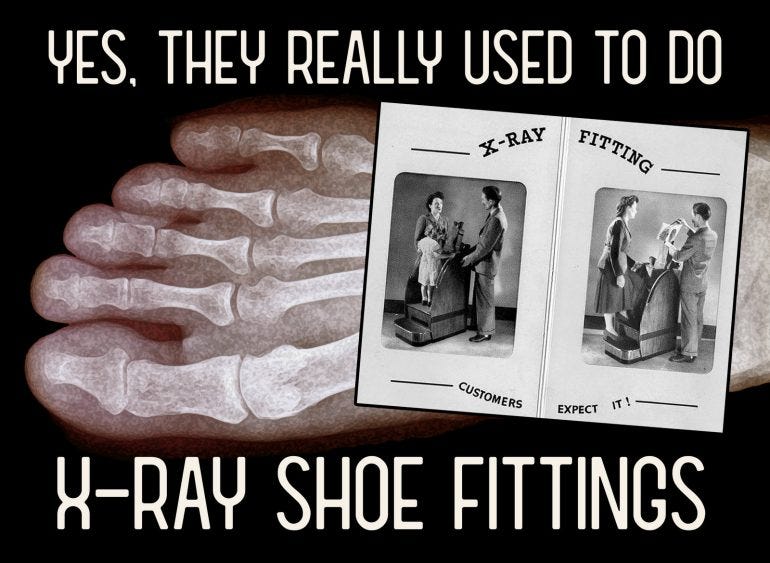
In the early to mid-20th century, a peculiar device became a common fixture in shoe stores: the shoe-fitting fluoroscope. Customers—especially parents with children—were captivated by this cutting-edge technology, which promised the perfect fit by using X-rays to reveal how shoes aligned with feet. At a time when radiation was still a scientific marvel, these machines were seen as symbols of modern convenience and progress. But beneath the veneer of technological sophistication lay a story of profound public health negligence, one that left a hidden legacy of illnesses among those unwittingly exposed.

Despite the promise of these machines, which were often celebrated as a blend of science and consumer service, shoe-fitting fluoroscopes came with a dangerous cost.
For decades, retailers enthusiastically deployed these devices to boost shoe sales, while regulatory oversight lagged far behind. The potential risks were largely ignored or downplayed, resulting in a generation unknowingly exposed to dangerous levels of radiation—especially children, who were seen as ideal users of this "scientific" fitting tool.
As we unravel the history of the shoe-fitting fluoroscope, we’ll explore not only the origins and widespread adoption of this technology but also the darker side of its legacy: the long-term health impacts, the troubling connections to other toxic exposures of the era, and how this unchecked enthusiasm for technological solutions led to consequences that still linger today.
Discovery of X-Rays: Wilhelm Röntgen’s Breakthrough
In 1895, German physicist Wilhelm Conrad Röntgen accidentally discovered X-rays while experimenting with cathode rays in a vacuum tube. He observed that invisible rays could pass through materials and create images, famously capturing the first X-ray of his wife’s hand, revealing her bones and ring. This discovery, which earned him the first Nobel Prize in Physics in 1901, revolutionized medicine by enabling non-invasive diagnostics. However, the widespread excitement over this new technology led to reckless uses, like the shoe-fitting fluoroscope, long before the dangers of radiation exposure were fully understood.

The Origins of the Shoe-Fitting Fluoroscope: A Technological Marvel?
The shoe-fitting fluoroscope was first introduced in the 1920s. The idea behind it was simple: allow customers to see an X-ray image of their feet inside their shoes to ensure a perfect fit. The machine was designed with three viewing ports—one for the customer, one for the salesperson, and one for an observer—making the experience a group event.
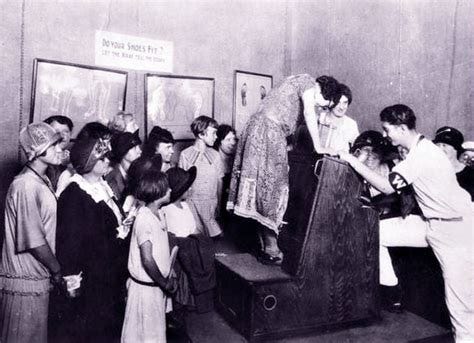
The technology was initially developed by Dr. Jacob Lowe, among others, who believed it could solve the age-old problem of ill-fitting shoes by allowing people to see exactly how their feet aligned inside the footwear.
Manufacturers quickly seized on the opportunity, producing thousands of these machines and marketing them to shoe stores across the United States, Canada, and Europe. The Pedoscope Company in the UK was one of the major players in this industry, promoting the fluoroscope as a must-have for shoe retailers looking to attract more customers.
By the 1930s and 1940s, it was not uncommon to see children standing on fluoroscope platforms in shoe stores, fascinated by the greenish glow of their foot bones on display.

Why Was This Dangerous Technology Allowed in Stores?
While the concept of using X-rays seemed innovative and cutting-edge, the risks were already well-known within scientific circles. Since the early 1900s, cases of radiation burns, cancers, and other health problems had been documented among those using X-ray technology. However, the public was largely unaware of these dangers, and shoe retailers saw the fluoroscope as a surefire way to increase sales. With little to no regulation on the use of X-ray machines outside of hospitals, these devices became a retail novelty, capitalizing on the public’s fascination with science.
The pushback from medical experts who recognized the dangers of radiation exposure was largely ignored by shoe store owners and fluoroscope manufacturers. The industry argued that the doses were too low to cause harm. In reality, many machines were poorly calibrated, and customers, especially children, were subjected to far higher levels of radiation than originally claimed. These exposures accumulated over time, leading to long-term health consequences.

The Military Connection: Soldiers Subjected to Shoe-Fitting X-Rays
The use of fluoroscopes wasn’t limited to children in shoe stores. During World War II, these machines were also used to ensure soldiers had properly fitting boots. Military officials believed that well-fitted footwear would reduce foot injuries on the battlefield, which was critical for troop mobility. Unfortunately, this practice exposed soldiers to harmful radiation, compounding the health risks they already faced from numerous other forms of radiation exposure during the war.
Health Impacts: The Unseen Legacy on the Silent Generation and Baby Boomers
The true extent of the damage caused by shoe-fitting fluoroscopes did not become apparent until years later. Many of those who stood on these machines as children grew up to face unexplained health issues. Individuals from the Silent Generation between 1920-1945 and Baby boomers born between 1946-1964, in particular, were heavily exposed to this technology during its heyday.
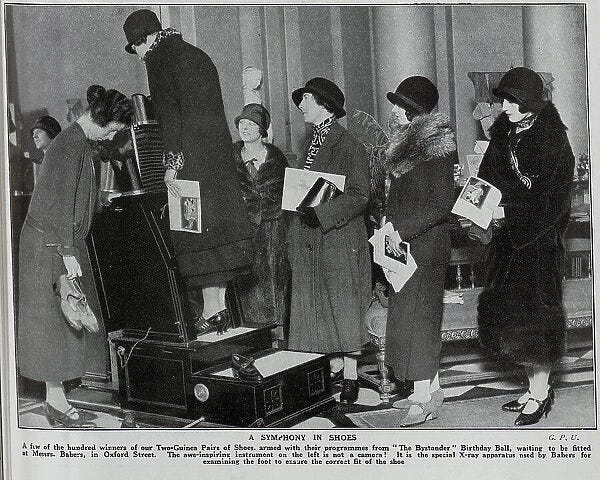
Long-Term Effects on the Silent Generation and Baby Boomers:
Could foot cancers and other foot issues be linked to this practice?
The widespread use of shoe-fitting fluoroscopes, which emitted radiation to view foot bones, raises the possibility that foot cancers and other foot-related health issues might be linked to this practice. Repeated radiation exposure—whether in children, adults, or those who used the devices regularly—could have contributed to the development of cancers and other long-term foot problems. Could this past practice have left lasting health consequences?
Autoimmune Disorders: Chronic radiation exposure could also play a role in the development of autoimmune diseases like fibromyalgia, rheumatoid arthritis, Sjogren's Syndrome, and lupus.
Radiation exposure causes oxidative stress and chronic inflammation, which may trigger neuropathic pain and central nervous system sensitization. This could contribute to symptoms like widespread pain, fatigue, and cognitive issues associated with autoimmune disorders. These conditions have become more prevalent among baby boomers, who were exposed to fluoroscopes during childhood. The radiation may have dysregulated their immune systems, leading to conditions where the body mistakenly attacks its own tissues. Could exposure to radiation from sources like the x-ray shoe machine, along with other forms of radiation, have contributed to autoimmune issues in later generations—people who may not even be aware that they were exposed to radiation before they were born?
Increased Cancer Risk: Besides foot cancers, exposure to ionizing radiation is linked to bone cancers, thyroid issues, and soft tissue sarcomas. These risks could have compounded over decades, leading to a higher incidence of cancers among those exposed to fluoroscopes.
The health effects of radiation accumulation over a lifetime are vast and complex, with risks that extend far beyond immediate harm. Unlike other environmental toxins, radiation can cause cellular damage that may not manifest for years or even decades. As the body absorbs radiation, the damage accumulates, potentially leading to conditions like cancer, autoimmune disorders, and genetic mutations.
Over time, the body may lose its ability to repair these damaged cells, increasing the likelihood of chronic diseases and health complications. The potential long-term effects are endless, ranging from increased cancer risks to disruptions in the endocrine and immune systems, with varying severity depending on factors like exposure levels, age, and overall health.

Conveniently, many of these disorders are often dismissed as having no known origin or are blamed on viruses that don’t exist, allowing the true causes of these illnesses to remain hidden. This deflection not only prevents meaningful solutions from being found but also leaves individuals to suffer without understanding the underlying source of their health problems.

Connecting the Dots: Could Fluoroscopes and DDT Have Exacerbated Polio?
One of the most intriguing theories emerging from this era is the possible connection between radiation exposure and the polio epidemic.
The widespread use of shoe-fitting fluoroscopes coincided with the peak of polio cases in the 1940s and 1950s. At the same time, children were heavily exposed to DDT, a pesticide later found to be neurotoxic.
Some researchers theorize that chronic radiation exposure from fluoroscopes may have weakened children's immune systems, making them more vulnerable to polio infections. The additional burden of DDT exposure could have compounded these effects, leading to an epidemic that was far worse than it might have been otherwise. While this theory remains controversial, it raises important questions about how environmental factors and technology can interact in unexpected and harmful ways.
The Demise of the Shoe-Fitting Fluoroscope: Too Little, Too Late
By the late 1950s, growing awareness of the dangers of radiation finally led to a crackdown on shoe-fitting fluoroscopes. Regulatory agencies, including the FDA, began to restrict their use, and many machines were eventually banned from stores. However, by that time, millions of people had already been exposed. The slow response of regulators and the profit-driven motives of the shoe industry left generations with health consequences that seems to be largely unexplored and statistics of those impacted unknown.
A Warning from History
The story of the shoe-fitting fluoroscope is a sobering reminder of how easily new technologies can be misused when profits and public fascination override safety concerns. It serves as a cautionary tale about the need for rigorous oversight, especially when it comes to technologies that directly affect public health. As we continue to embrace new technologies, from medical devices to consumer gadgets, we must remember the lessons of the past to avoid repeating the same mistakes.

***A very big THANK YOU to Consuelo for letting me know about this!







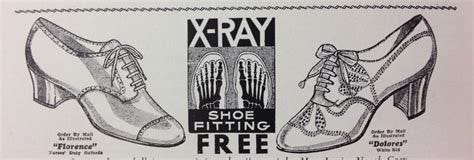


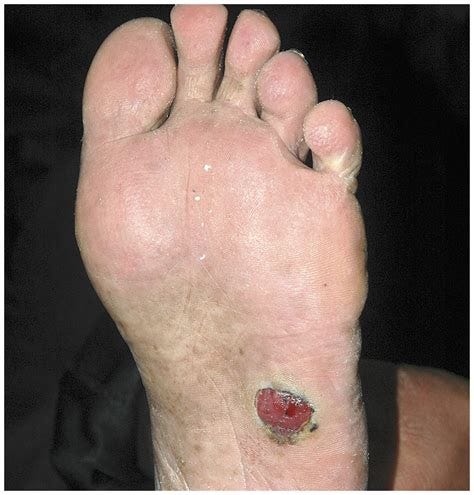
![Fibromyalgia [Infographic] - Visualistan Fibromyalgia [Infographic] - Visualistan](https://substackcdn.com/image/fetch/$s_!Gphn!,w_1456,c_limit,f_auto,q_auto:good,fl_progressive:steep/https%3A%2F%2Fsubstack-post-media.s3.amazonaws.com%2Fpublic%2Fimages%2Ff06ac547-7226-474a-a4f8-244fc92b93f2_474x327.jpeg)






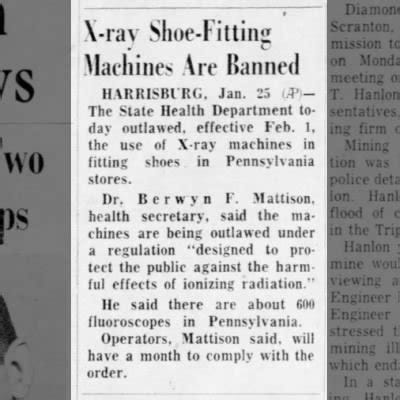
Great article, lots of photos. My mother and her siblings told of being sprayed down with DDT in the 40s and 50s, probably had their feet xrayed also, so no wonder she was prone to getting lymphoma especially using the highly poisonous Arrid XXX extra dry underarm spray for 10 years prior.
Thank you.
But who knows? Nothing obvious like cancer on our feet. But certainly immune system problems. But then again, it could be the years of vaccines, the pharma drugs, ddt, fluoride horrible diet, etc. Or all of them together. Like most other people I grew up with, or know now.
Shortening our lifespans have been in the works for a long time. Many of my great-grandmothers and -fathers, great-aunts and uncles, grandparents lived into their 90's, 100's and none had alzheimers, etc. Basically, died of old age. Parents died before reaching 90, both of cancer. I think this general timeline applies to many of my generation and younger. Then a huge number are dying from the shots and other poisons, turbocancers, etc.
ETA: You might be interested to know that the treatment for lice, per the doctors, used to be to shake powdered DTT in the child's hair daily and comb it through with a fine toothed comb for days or weeks untill all traces of the lice were gone.